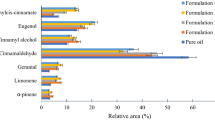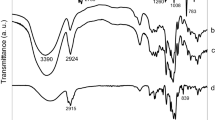Abstract
In this paper, the effect of different deep eutectic solvents (DESs) on the yield of cinnamon oil was studied, and the extraction conditions were optimized. Then, the cinnamon essential oil microcapsule was prepared by complex coacervation method. The morphology, chemical structure, and thermal stability were characterized by Scanning electron microscopy (SEM), Fourier transforms infrared spectroscopy (FTIR), and Thermogravimetric analysis (TGA). The research results showed that the optimum DES for the cinnamon oil extraction was choline chloride: 1,2-propanediol, their molar ratio was 1:3 and the water content of 40%. The optimal extraction conditions were the solid–liquid ratio was 1:6, the extraction temperature was 70 °C, the extraction time was 10 min, and the distillation time was 50 min. The optimal extraction rate was 4.464%, which was higher than that of the conventional hydrodistillation (HD) method (1.581%). It was found by the characterizations that the microcapsules were full spherical under SEM. The FTIR showed the interaction of the gelatin, gum Arabic acid, and tannic acid. The TGA result showed that microencapsulated essential oil could improve the thermal stability of essential oil. This study provides some ideas for the extraction and application of cinnamon essential oil.




Similar content being viewed by others
References
K. Yang et al., Preparation and characterization of cinnamon essential oil nanocapsules and comparison of volatile components and antibacterial ability of cinnamon essential oil before and after encapsulation. Food Control 123, 107783 (2021)
J. Gruenwald, J. Freder, N. Armbruester, Cinnamon and health. Crit. Rev. Food Sci. Nutr. 50(9), 822–834 (2010)
Z. Hussain et al., Influence of adding cinnamon bark oil on meat quality of ground lamb during storage at 4 °C. Meat Sci. 171, 108269 (2021)
S.K. Ezzat et al., Effects of aqueous cinnamon extract on chemically-induced carcinoma of hamster cheek pouch mucosa. Biochem. Biophys. Rep. 12, 72–78 (2017)
N. Singh et al., Phytochemical and pharmacological review of Cinnamomum verum J. Presl-a versatile spice used in food and nutrition. Food Chem. 338, 127773 (2021)
M. Francisco et al., Essential oil deterpenation by solvent extraction using 1-ethyl-3-methylimidazolium 2-(2-methoxyethoxy) ethylsulfate ionic liquid. Fluid Phase Equilib. 296(2), 149–153 (2010)
Y. Xiao et al., Improved method to obtain essential oil, asarinin and sesamin from Asarum heterotropoides var. mandshuricum using microwave-assisted steam distillation followed by solvent extraction and antifungal activity of essential oil against Fusarium spp. Ind. Crops Prod. 162, 113295 (2021)
P.I. Modi, J.K. Parikh, M.A. Desai, Sonohydrodistillation: Innovative approach for isolation of essential oil from the bark of cinnamon. Ind. Crops Prod. 142, 111838 (2019)
F. Yi et al., Influence of molecular distillation on antioxidant and antimicrobial activities of rose essential oils. LWT 102, 310–316 (2019)
A.P. Abbott et al., Deep eutectic solvents formed between choline chloride and carboxylic acids: versatile alternatives to ionic liquids. J. Am. Chem. Soc. 126(29), 9142–9147 (2004)
X.Q. Xiong et al., Application of deep-eutectic solvents in green organic synthesis. Chin. J. Org. Chem. 36(3), 480–489 (2016)
Q.H. Zhang et al., Deep eutectic solvents: syntheses, properties and applications. Chem. Soc. Rev. 41(21), 7108–7146 (2012)
W. Tang, Y. An, K.H. Row, Emerging applications of (micro) extraction phase from hydrophilic to hydrophobic deep eutectic solvents: opportunities and trends. Trends Anal. Chem. 136, 116187 (2021)
Y. Dai, R. Verpoorte, Y.H. Choi, Natural deep eutectic solvents providing enhanced stability of natural colorants from safflower (Carthamus tinctorius). Food Chem. 159, 116–121 (2014)
Y. Dai et al., Application of natural deep eutectic solvents to the extraction of anthocyanins from Catharanthus roseus with high extractability and stability replacing conventional organic solvents. J. Chromatogr. A 1434, 50–56 (2016)
X.-P. Wang et al., Preconcentration of liposoluble constituents in Salvia miltiorrhiza using acid-assisted liquid phase microextraction based on a switchable deep eutectic solvent. J. Chromatogr. A 1666, 462858 (2022)
Y. Liu et al., Enhanced extraction of natural pigments from Curcuma longa L. using natural deep eutectic solvents. Ind. Crops Prod. 140, 111620 (2019)
A. Shishov et al., Deep eutectic solvent-based extraction of metals from oil samples for elemental analysis by ICP-OES. Microchem. J. 179, 107456 (2022)
D. Çıtak, D. Sabancı, Response surface methodology and hydrophobic deep eutectic solvent based liquid phase microextraction combination for determination of cadmium in food and water samples. J. Food Meas. Charact. 15(2), 1843–1850 (2021)
N. Ismail et al., Non-ionic deep eutectic solvents for membrane formation. J. Membr. Sci. 646, 120238 (2022)
Y. Liu et al., Preparation and properties of biodegradable films made of cationic potato-peel starch and loaded with curcumin. Food Hydrocoll. 130, 107690 (2022)
R. Alcalde et al., An experimental and theoretical investigation of the physicochemical properties on choline chloride—lactic acid based natural deep eutectic solvent (NADES). J. Mol. Liq. 290, 110916 (2019)
V. Vorobyova, M. Skiba, G. Vasyliev, Extraction of phenolic compounds from tomato pomace using choline chloride–based deep eutectic solvents. J. Food Meas. Charact. 16(2), 1087–1104 (2022)
Z. Naseem et al., Use of hydrogen-bonded supramolecular eutectic solvents for eco-friendly extraction of bioactive molecules from Cymbopogon citratus using Box-Behnken design. J. Food Meas. Charact. 15(2), 1487–1498 (2021)
Y. Dai et al., Natural deep eutectic solvents as new potential media for green technology. Anal. Chim. Acta 766, 61–68 (2013)
M.D.L.Á. Fernández et al., Natural deep eutectic solvents-mediated extractions: the way forward for sustainable analytical developments. Anal. Chim. Acta 1038, 1–10 (2018)
Y. Zhao et al., Three-stage microwave extraction of cumin (Cuminum cyminum L.) Seed essential oil with natural deep eutectic solvents. Ind. Crops Prod. 140, 111660 (2019)
Y.-Q. Li, D.-X. Kong, H. Wu, Analysis and evaluation of essential oil components of cinnamon barks using GC–MS and FTIR spectroscopy. Ind. Crops Prod. 41, 269–278 (2013)
K.R. Ng et al., Antimicrobial and antioxidant activities of phenolic metabolites from flavonoid-producing yeast: potential as natural food preservatives. Food Chem. 270, 123–129 (2019)
Z.B. Xiao et al., A review of the preparation and application of flavour and essential oils microcapsules based on complex coacervation technology. J. Sci. Food Agric. 94(8), 1482–1494 (2014)
M. Anvari, D. Chung, Dynamic rheological and structural characterization of fish gelatin—gum arabic coacervate gels cross-linked by tannic acid. Food Hydrocoll. 60, 516–524 (2016)
Y. Liu et al., Microencapsulation of Osmanthus essential oil by interfacial polymerization: optimization, characterization, release kinetics, and storage stability of essential oil from microcapsules. J. Food Sci. 86(12), 5397–5408 (2021)
M. Vilková, J. Płotka-Wasylka, V. Andruch, The role of water in deep eutectic solvent-base extraction. J. Mol. Liq. 304, 112747 (2020)
C. Fu et al., Research on the optimization, key chemical constituents and antibacterial activity of the essential oil extraction process of Thuja koraiensis Nakai. J. Microbiol. Methods 194, 106435 (2022)
Y.Q. Li et al., Quality evaluation for essential oil of Cinnamomum verum leaves at different growth stages based on GC-MS. FTIR and microscopy. Food Anal. Methods 9(1), 202–212 (2016)
N. Jeyaratnam et al., Essential oil from Cinnamomum cassia bark through hydrodistillation and advanced microwave assisted hydrodistillation. Ind. Crops Prod. 92, 57–66 (2016)
M.A. Ferhat et al., An improved microwave Clevenger apparatus for distillation of essential oils from orange peel. J. Chromatogr. A 1112(1), 121–126 (2006)
A. Jayatilaka et al., Simultaneous micro steam distillation/solvent extraction for the isolation of semivolatile flavor compounds from cinnamon and their separation by series coupled-column gas chromatography. Anal. Chim. Acta 302(2), 147–162 (1995)
T. Yu et al., GC-MS analysis of volatiles in cinnamon essential oil extracted by different methods. Grasas Aceites 71, 372 (2020)
Z. Huang et al., Synergistic effects of cinnamaldehyde and cinnamic acid in cinnamon essential oil against S. pullorum. Ind. Crops Prod. 162, 113296 (2021)
R. Wang, R. Wang, B. Yang, Extraction of essential oils from five cinnamon leaves and identification of their volatile compound compositions. Innov. Food Sci. Emerg. Technol. 10(2), 289–292 (2009)
N.G. Vasconcelos, J. Croda, S. Simionatto, Antibacterial mechanisms of cinnamon and its constituents: a review. Microb. Pathog. 120, 198–203 (2018)
M.J. Paris et al., Modelling release mechanisms of cinnamon (Cinnamomum zeylanicum) essential oil encapsulated in alginate beads during vapor-phase application. J. Food Eng. 282, 110024 (2020)
N. Zamindar, S. Haraji, M. Doudi, Antifungal effect of cinnamon essential oil on Byssochlamys fulva in liquid medium and tomato sauce. J. Food Meas. Charact. 9(4), 586–591 (2015)
B. Muhoza, S. Xia, X. Zhang, Gelatin and high methyl pectin coacervates crosslinked with tannic acid: the characterization, rheological properties, and application for peppermint oil microencapsulation. Food Hydrocoll. 97, 105174 (2019)
B. Muhoza et al., Gelatin and pectin complex coacervates as carriers for cinnamaldehyde: effect of pectin esterification degree on coacervate formation, and enhanced thermal stability. Food Hydrocoll. 87, 712–722 (2019)
Acknowledgements
This work was supported by The Project program of Key Laboratory of Food Nutrition and Safety, Ministry of Education & Tianjin Key Laboratory of Food Nutrition and Safety, China (No. TJS202003) and the National Key Research and Development Program (2017YFD0400106-02).
Author information
Authors and Affiliations
Contributions
All authors contributed to the studys conception and design. Conceptualization, methodology and supervision: YL and SW; data analysis, software, validation, and writing—original draft: RF and HW; writing—review and editing: ML, LZ, WC and RW.
Corresponding author
Ethics declarations
Conflict of interest
There are no conflict of interest to declare.
Additional information
Publisher's Note
Springer Nature remains neutral with regard to jurisdictional claims in published maps and institutional affiliations.
Supplementary Information
Below is the link to the electronic supplementary material.
Rights and permissions
Springer Nature or its licensor (e.g. a society or other partner) holds exclusive rights to this article under a publishing agreement with the author(s) or other rightsholder(s); author self-archiving of the accepted manuscript version of this article is solely governed by the terms of such publishing agreement and applicable law.
About this article
Cite this article
Liu, Y., Wang, H., Fu, R. et al. Preparation and characterization of cinnamon essential oil extracted by deep eutectic solvent and its microencapsulation. Food Measure 17, 664–673 (2023). https://doi.org/10.1007/s11694-022-01653-2
Received:
Accepted:
Published:
Issue Date:
DOI: https://doi.org/10.1007/s11694-022-01653-2




